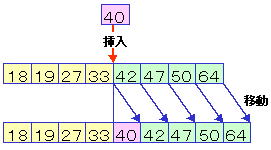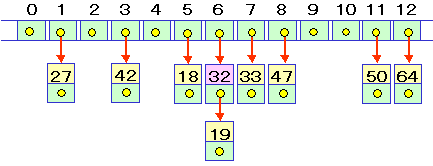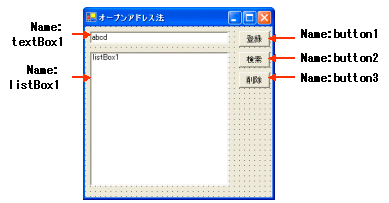

|
丂丂丂丂丂  丂丂丂丂丂丂丂4丏5 僴僢僔儏朄 丂丂丂丂丂丂丂4丏5 僴僢僔儏朄 |
|||||||||||||||||||||||||||||||||||||||||||||||||||||||||||||||||||||||||||||||||||||||
|
|
|||||||||||||||||||||||||||||||||||||||||||||||||||||||||||||||||||||||||||||||||||||||
| 斣崋 | 埲壓傪僋儕僢僋偡傞偲丆奩摉売強偵僕儍儞僾偟傑偡 |
| 乮侾乯 | 僴僢僔儏朄乮hashing乯偲偼 |
| 乮俀乯 | 僉乕抣偺徴撍 |
| 乮俁乯 | 僠僃僀儞朄 |
| 乮係乯 | 僆乕僾儞傾僪儗僗朄 |
| 乮俆乯 | 暥帤楍偺僴僢僔儏抣 |


| 斣崋 | 埲壓傪僋儕僢僋偡傞偲丆奩摉売強偵僕儍儞僾偟傑偡 |
| 乮侾乯 | 僴僢僔儏朄乮hashing乯偲偼 |
| 乮俀乯 | 僉乕抣偺徴撍 |
| 乮俁乯 | 僠僃僀儞朄 |
| 乮係乯 | 僆乕僾儞傾僪儗僗朄 |
| 乮俆乯 | 暥帤楍偺僴僢僔儏抣 |


| 仭僠僃僀儞朄 | 丗摨堦抣傪傕偮梫慺傪慄宍儕僗僩偱娗棟偡傞曽朄 |
| 仭僆乕僾儞傾僪儗僗朄 | 丗嬻偒僶働僢僩傪尒偮偗傞傑偱僴僢僔儏傪孞傝曉偡曽朄 |
| 斣崋 | 埲壓傪僋儕僢僋偡傞偲丆奩摉売強偵僕儍儞僾偟傑偡 |
| 乮侾乯 | 僴僢僔儏朄乮hashing乯偲偼 |
| 乮俀乯 | 僉乕抣偺徴撍 |
| 乮俁乯 | 僠僃僀儞朄 |
| 乮係乯 | 僆乕僾儞傾僪儗僗朄 |
| 乮俆乯 | 暥帤楍偺僴僢僔儏抣 |



| // 僨乕僞愰尵 public struct NumberListData { 丂丂public int Data; 丂丂public int Pointer; } public const int AREASIZE = 50; public const int HASHSIZE = 16; public int ErasePointer; public static NumberListData[] 丂丂 NumberList=new NumberListData[AREASIZE]; public int[] Bucket=new int[HASHSIZE]; // 僶働僢僩椞堟偺弶婜壔 public void BucketInitialize() { 丂丂for(int i=0;i<Bucket.Length;i++) Bucket[i]=-1; } // 慄宍儕僗僩奿擺椞堟偺娗棟 public void AreaInitialize() { 丂丂int i; 丂丂for(i=0;i<NumberList.Length;i++) NumberList[i].Pointer=i+1; 丂丂NumberList[NumberList.Length-1].Pointer=-1; 丂丂 ErasePointer=0; } public int GetArea() { 丂丂if (ErasePointer<0) return -1; 丂丂int P=ErasePointer; 丂丂ErasePointer=NumberList[ErasePointer].Pointer; 丂丂return P; } public void FreeArea(int P) {丂丂NumberList[P].Pointer=ErasePointer; 丂丂ErasePointer=P; } // 慄宍儕僗僩偺憖嶌 public int replaca(int P, int A) { NumberList[P].Data=A; return P; } public int replacd(int P, int A) { NumberList[P].Pointer=A; return A;} public int car(int P) { return NumberList[P].Data;} public int cdr(int P) { return NumberList[P].Pointer;} public int cons(int A, int B) { 丂丂int P=GetArea(); if(P<0) return -1; 丂丂NumberList[P].Data=A; NumberList[P].Pointer=B; 丂丂return P; } //丂張棟弶婜愝掕偲嫟捠儖乕僠儞 private void Form1_Load(object sender, System.EventArgs e) {丂 BucketInitialize(); AreaInitialize(); 億僀儞僞晹偺昞帵(); } private void 億僀儞僞晹偺昞帵() { 丂丂listBox1.Items.Clear(); 丂丂listBox1.Items.Add("Erase Pointer=" + ErasePointer.ToString()); 丂丂listBox1.Items.Add("(億僀儞僞晹偺傒)"); 丂丂int i=ErasePointer; 丂丂while(i>=0) { i=cdr(i);listBox1.Items.Add(i.ToString());} } // 椞堟娗棟偺僥僗僩 private void button1_Click(object sender, System.EventArgs e) { 丂丂int P=GetArea(); string PS=P.ToString(); 丂丂textBox1.Text=PS; 億僀儞僞晹偺昞帵(); 丂丂MessageBox.Show (PS); } private void button2_Click(object sender, System.EventArgs e) { 丂丂FreeArea(int.Parse(textBox1.Text)); 億僀儞僞晹偺昞帵(); } // 僴僢僔儏僥乕僽儖偺昞帵 private void 僴僢僔儏昞帵() { 丂丂丂string S; int P; 丂丂丂listBox1.Items.Clear(); 丂丂丂for(int i=0;i<Bucket.Length;i++) 丂丂丂{ 丂丂丂丂丂 S=i.ToString()+" "; P=Bucket[i]; 丂丂丂丂丂if(P>=0) 丂丂丂丂丂{ 丂丂丂丂丂丂丂丂while(P>=0) { S += " " + car(P).ToString(); P=cdr(P); } 丂丂丂丂丂丂丂丂listBox1.Items.Add(S); 丂丂丂丂丂丂} 丂丂丂丂丂 else listBox1.Items.Add(S+"(嬻)"); 丂丂丂丂} } //丂慄宍儕僗僩偺昞帵 private int SearchKey(int Key, int P) { 丂丂int PP=P; 丂丂while(PP>=0) 丂丂{ 丂丂丂丂if(car(PP)==Key) return PP; 丂丂丂丂PP=cdr(PP); 丂丂} 丂丂return -1; } // 丂僴僢僔儏愝掕 private void 僴僢僔儏愝掕(int Key, int Mod) { 丂丂丂int ID = Key % Mod; 丂丂丂if(SearchKey(Key, Bucket[ID])<0) Bucket[ID]=cons(Key, Bucket[ID]); } private void button3_Click(object sender, System.EventArgs e) { 丂丂int Mod = Bucket.Length; 丂丂int Key = int.Parse(textBox1.Text) ; 丂丂僴僢僔儏愝掕(Key, Mod); 丂丂僴僢僔儏昞帵(); } //丂僴僢僔儏扵嶕 private int 僴僢僔儏扵嶕(int Key, int Mod) { 丂丂丂int ID = Key % Mod; return SearchKey(Key, Bucket[ID]); } private void button4_Click(object sender, System.EventArgs e) { 丂丂int Mod = Bucket.Length; 丂丂int Key = int.Parse(textBox1.Text) ; 丂丂int P = 僴僢僔儏扵嶕(Key, Mod); 丂丂MessageBox.Show(P.ToString()); } //丂僴僢僔儏嶍彍 private int 僴僢僔儏嶍彍(int Key, int Mod) { 丂丂int ID = Key % Mod; 丂丂int Befor = -1;丂int P = Bucket[ID]; 丂丂if(P<0) return -1; 丂丂while(P >= 0) 丂丂{ 丂丂丂丂if(car(P) == Key) break; 丂丂丂丂Befor = P; 丂丂丂丂P = cdr(P); 丂丂} 丂丂int After = cdr(P); FreeArea(P); 丂丂if(Befor < 0) Bucket[ID] = After; 丂丂else replacd(Befor, After); 丂丂return After; } private void button5_Click(object sender, System.EventArgs e) { 丂丂int Mod = Bucket.Length; 丂丂int Key = int.Parse(textBox1.Text) ; 丂丂int P = 僴僢僔儏嶍彍(Key, Mod); 丂丂僴僢僔儏昞帵(); } |
| 斣崋 | 埲壓傪僋儕僢僋偡傞偲丆奩摉売強偵僕儍儞僾偟傑偡 |
| 乮侾乯 | 僴僢僔儏朄乮hashing乯偲偼 |
| 乮俀乯 | 僉乕抣偺徴撍 |
| 乮俁乯 | 僠僃僀儞朄 |
| 乮係乯 | 僆乕僾儞傾僪儗僗朄 |
| 乮俆乯 | 暥帤楍偺僴僢僔儏抣 |




| 斣崋 | 埲壓傪僋儕僢僋偡傞偲丆奩摉売強偵僕儍儞僾偟傑偡 |
| 乮侾乯 | 僴僢僔儏朄乮hashing乯偲偼 |
| 乮俀乯 | 僉乕抣偺徴撍 |
| 乮俁乯 | 僠僃僀儞朄 |
| 乮係乯 | 僆乕僾儞傾僪儗僗朄 |
| 乮俆乯 | 暥帤楍偺僴僢僔儏抣 |
| 丂丂 | private int 僴僢僔儏抣(string S, int H) { 丂丂int CH = 0; 丂丂for(int i = 0; i < S.Length; i++) 丂丂丂丂{ CH +=(int) (S[i] % H); CH %= H; } 丂丂return CH; } |
| 仭嶍彍儅乕僋丂 | 丗丂乬\n乭 |
| 仭枹搊榐僶働僢僩丂丂 | 丗丂乬\r乭 |

| private const int HASHVALUE=16; private string[] Bucket = new string[HASHVALUE*2]; private void 僴僢僔儏搊榐(string Str, int HashMod) { 丂丂int ID=僴僢僔儏抣(Str, HashMod); 丂丂while(Bucket[ID]!="\r" && Bucket[ID]!="\n" && ID<Bucket.Length) 丂丂{ 丂丂丂丂丂if(Str==Bucket[ID]) 丂丂丂丂丂{ 丂丂丂丂丂丂丂 MessageBox.Show("摨堦暥帤楍偑搊榐偝傟偰偄傑偡"); 丂丂丂丂丂丂丂丂return; 丂丂丂丂丂} 丂丂丂丂丂ID++; 丂丂丂} 丂丂丂if (ID>=Bucket.Length)MessageBox.Show("搊榐偱偒傑偣傫"); 丂丂丂else Bucket[ID]=Str; } private int 僴僢僔儏扵嶕(string Str, int HashMod) { 丂丂int ID=僴僢僔儏抣(Str, HashMod); 丂丂while(Bucket[ID]!="\r" && ID<Bucket.Length) 丂丂{ 丂丂丂丂if(Str==Bucket[ID]) return ID; 丂丂丂丂ID++; 丂丂} 丂丂return -1; } private void 僴僢僔儏嶍彍(string Str, int HashMod) { 丂丂int ID = 僴僢僔儏扵嶕(Str , HashMod); 丂丂if(ID>=0) Bucket[ID]="\n"丟 } private void 僴僢僔儏昞帵() { 丂丂listBox1.Items.Clear(); 丂丂for(int i=0;i<Bucket.Length;i++) 丂丂{ 丂丂丂丂if(Bucket[i]=="\r")丂丂丂丂listBox1.Items.Add("----"); 丂丂丂丂else if(Bucket[i]=="\n") listBox1.Items.Add("****"); 丂丂丂丂else丂丂丂丂丂丂丂丂丂丂丂丂丂丂listBox1.Items.Add(Bucket[i]); 丂丂} } private void button1_Click(object sender, System.EventArgs e) { 丂丂string V = textBox1.Text; 僴僢僔儏搊榐(V , HASHVALUE); 丂丂僴僢僔儏昞帵(); } private int 僴僢僔儏抣(string S, int H) { 丂丂int CH = 0; 丂丂for(int i = 0; i < S.Length; i++) 丂丂丂丂丂丂丂丂{ CH +=(int) (S[i] % H); CH %= H; } 丂丂return CH; } private void Form1_Load(object sender, System.EventArgs e) { 丂丂for(int i=0;i<Bucket.Length;i++) Bucket[i]="\r"; 丂丂僴僢僔儏昞帵(); } private void button2_Click(object sender, System.EventArgs e) { 丂丂string V = textBox1.Text; 丂丂int ID = 僴僢僔儏扵嶕(V , HASHVALUE); 丂丂listBox1.SelectedIndex = ID; } private void button3_Click(object sender, System.EventArgs e) { 丂丂string V = textBox1.Text;丂僴僢僔儏嶍彍(V , HASHVALUE); 丂丂僴僢僔儏昞帵(); } // listBox1偑慖戰偝傟偨傜丆偦偺暥帤楍傪textBox1偵堏偡丅 private void listBox1_SelectedIndexChanged 丂丂丂丂丂丂丂丂丂(object sender, System.EventArgs e) 丂{ textBox1.Text=listBox1.Text; } |
| 斣崋 | 埲壓傪僋儕僢僋偡傞偲丆奩摉売強偵僕儍儞僾偟傑偡 |
| 乮侾乯 | 僴僢僔儏朄乮hashing乯偲偼 |
| 乮俀乯 | 僉乕抣偺徴撍 |
| 乮俁乯 | 僠僃僀儞朄 |
| 乮係乯 | 僆乕僾儞傾僪儗僗朄 |
| 乮俆乯 | 暥帤楍偺僴僢僔儏抣 |